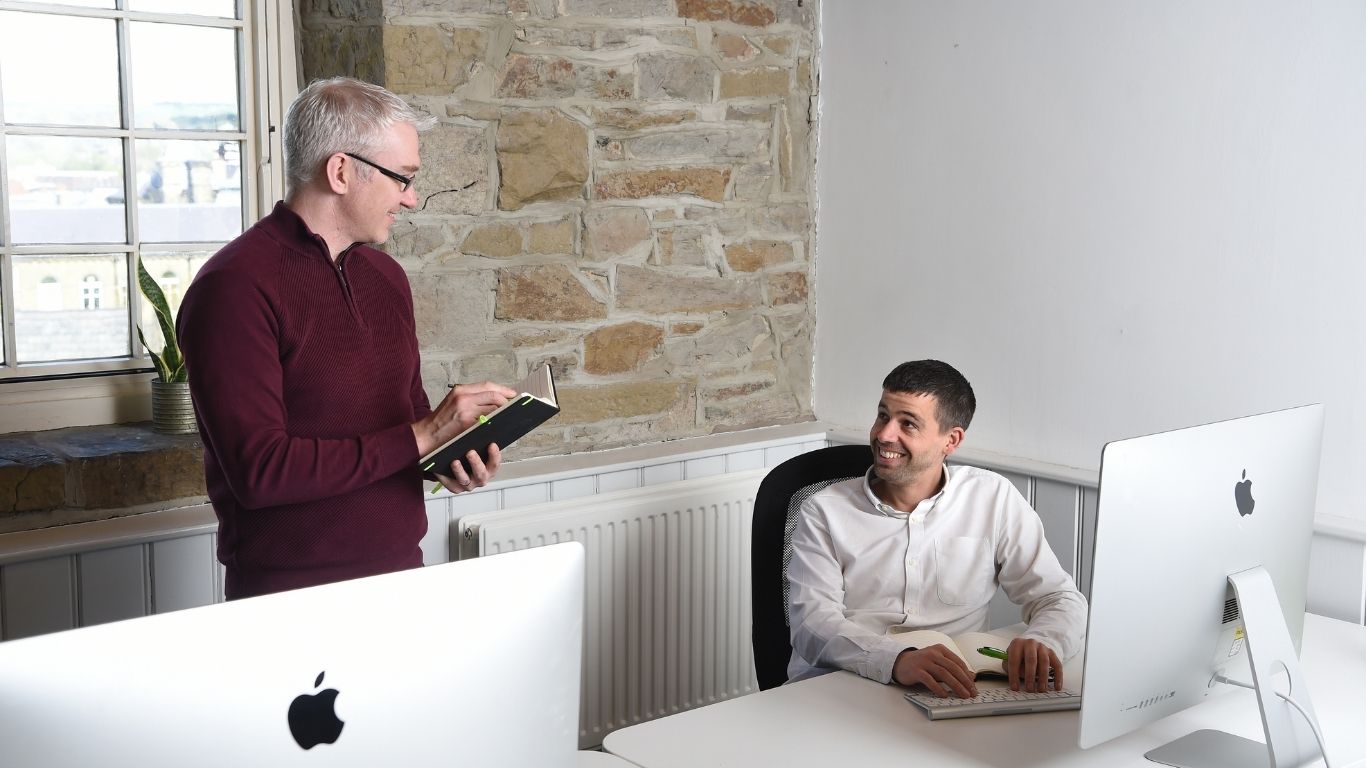Ready to explore the possibilities?
Request a quick call with our team to find out how the Innovation Explorer program can help your business take its next big leap into AI and automation.

Marketing in uncertain times
You don’t need a lengthy teardown of Coronavirus/COVID-19 from me here. The impacts and effects of the pandemic, and the subsequent global lockdown, are well documented by countless others.
The world business landscape is currently a very different place as we navigate the challenges of reduced movement, almost non-existent leisure and, for many of us, working from home. The Door4 team is entirely dispersed across Lancashire and Manchester (maybe even Yorkshire) and we continue to deliver our whole service set to our clients. It’s a different world, but there is a solid spine of “business-as-usual”. Pretty much.
So – a question our clients are asking right now:
How do we keep on ‘marketing’ our brand in these crazy times?
Have you asked yourself this, or have you given up?
- If you believe your brand can endure this situation and emerge at the other side ready for growth, read on!
- If you believe this situation spells the unfortunate end of your brand, marketing is probably not your priority, right now. But read on anyway.
What marketing strategies will help your brand survive?
First, let’s look at Google’s “See, Think, Do, Care” framework. This model has been around now for some years and, in essence, categories your entire audience – your past, present and future customers – into four distinct categories.
For the purposes of illustration, let’s assume every single one of your consumer (B2B, B2C, R2D2, whatever) will fit into ONE of these categories at any time. And let’s assume you sell T-shirts.
1. See, Think, Do, Care
SEE – your largest qualified audience: all the people that MIGHT buy your T-shirts. But these are people who are showing NO intent to actually buy right now.
THINK – your qualified audience: showing SOME intent to buy clothes, or T-shirts. But, they’re not really searching specifically for T-shirts, or your brand right now.
DO – your qualified audience: showing LOTS of intent, to buy clothes or T-shirts right now.. They’re searching for “T-shirts” in Google.
CARE – your loyal customers: they’ve already purchased from you, a couple of times. But they’re not looking to buy again just yet.
And why does this framework exist? In really, really simple terms, the ideal scenario for a brand (your brand) is to publish and amplify content to your customers in all four of these stages.
Put another way, using Google’s existing framework will help your brand power through this situation.
2. Content you need to publish and amplify
- Content for the See audience, who aren’t even thinking about buying. This is often referred to as “brand awareness”.
- Content for the Think audience, who are researching your category, but aren’t considering you (so, for our T-shirt brand example, “How to look great on lockdown Zoom calls”).
- Content for the Do audience, who are actively searching for a product or solution (in this case, responding to searches for ‘red t-shirts’ perhaps).
- Content for the Care audience, your most loyal customers. Those who act as your advocates, and those who perhaps need some assistance or guidance.
3. Put yourself in their, er, T-shirts
Right. With the framework out of the way, let’s think again about the situation we find ourselves in, late March early April 2020. All of us – especially your four groups of customers.
We’re locked down. We can’t go out and do the things we used to do. Not for a while. We can’t go to the gym, or the pub. Nor are we going to the office, as much. So, we’re not really buying clothes and shoes in the same way, either.
You can see how the demand chain is disrupted.
However, the one thing we’re doing – more than ever – is browsing the web. We’re battering the social networks, both because we’re searching for updates on (don’t say it) and because, let’s face it, we have LOTS more time on our hands to, y’know, scroll through Facebook, Instagram and LinkedIn.
You can see where I’m going with this.
See and Think are candidates for expansion
For many brands, DO is not an active space right now. Consumer demand to purchase discretionary and lifestyle goods is significantly down. This means that Paid Search (PPC), in particular, is impacted. Many brands have moved budget from Paid Search, if they can’t ship product. This is not to say that PPC is pointless right now… remember, you only pay when a consumer searches for something and you fulfil that request with your brand. You just need to ascertain whether the medium-term return justifies paying for the click, if it’s there.
Many smaller brands have focused on DO for years, because it’s the most straightforward to monetise. Somebody searching for:
- “Gym memberships near me” – let’s stick an ad on it.
- “Electric lawn mowers” – stick an ad there.
- “Jaguar F-Type Fuji White touch up paint” – let’s get an ad there.
Absolutely – when somebody is searching – Paid Search give us an immediate connection to that consumer, and a great chance to acquire a customer.
Instead, SEE and THINK are candidates for expansion. SEE and THINK consumers are a couple of steps away – these are broader, more complex stages to cover. Most notably, they are trickier to measure.
Anybody that has run radio or TV ads will know that this involves lots of guesswork, and it takes a confident marketer to boast that a campaign has fundamentally boosted their brand’s results. (This would bring us onto an attribution discussion – maybe next time!)
Now, with an enforced shift in consumer behaviour, brands must focus on the SEE and THINK consumer, more than ever. With a few weeks of lockdown (ed: you said it again!) in front of us, we are required to channel our efforts, to connect with the consumers that we expect to flood back, once this nonsense is all over. We WILL return to normal – possibly over a period of time – and the smart marketer knows that there is latent opportunity, waiting to be captured.
How do we pivot our marketing, then?
Let’s work backwards… THINK and then SEE.
THINK customer stage contains those individuals (again, B2C consumers, or B2B buyers) who continue to live their own life, and do their job… they continue to research the things that trouble them, browse fashion, browse cars, evaluate that new garden furniture set. Life hasn’t stopped entirely and many of us think that, after the short sharp shock of the last fortnight, a more typical consumer mindset will return.
THINK customers gives us a cue, and an insight – they are searching for related terms and browsing editorial websites, clicking on links from social networks:
- T-shirts – summer fashion
- 10 best electric cars in 2020
- Give your garden a makeover.
Crucially – they are consuming content that relates to their demands and desires – without necessarily making a purchase today.
This gives us an opportunity to do a few things, to cement our brand further into their consideration.
1. Focus on SEO for the Think-ers
On-page content, product and category descriptions, hub and hero campaign content for the website… all of these activities help you to build up that critical “Expertise, Authority and Trust.”
We’ve encountered many brands who, in recent years, have allowed their focus to shift entirely to Paid Media, their PPC campaigns delivering enough DO customers to make ends meet.
Now, we believe it is vital for brands to evaluate their own content and organic search performance. How can we use the opportunity that this situation presents? To boost on-page content, to develop those product and service descriptions and to finally begin to produce those blog/magazine articles that we intended to back in 2017!
SEO and content marketing remain absolutely fundamental to whole lifecycle marketing. This disrupted period means that there has never been a better time to focus senior team’s time on content creation.
2. Focus on Display for the See-ers
The SEE customer stage is tackled differently. These are customers that are showing little signs of intent.
They are our new car customer, probably likely to change their family saloon in late 2020. They’re not actively researching this yet, they’re passive. (Otherwise they would be in THINK of course.)
But surely, as a vehicle brand, we need to steal some of their mindshare, and make them consider our brand. Historically, this was the preserve of TV – certainly for larger brands with deeper pockets.
However, modern digital marketing means that every consumer is constantly connected to the stream of messaging that arises through the web and is amplified via social networks.
Display marketing allows us to deliver branded content directly to an audience that meet our very specific targeting criteria.
- Want to deliver ads to males, aged 35-45 in Manchester? Sure, we can do that
- Deliver a campaign to the over 60s in Essex, Aberdeen and Cardiff – no problem.
But throwing an ad for a brand in front of consumers requires some campaign thinking.
- What are the pains that our customer has, that our product solves?
- How do we present our solution to these pains, even though they don’t realise they had them?
- How do we ensure that our brand is memorable?
Takeaways
These techniques (SEO and display) combined provide us with a particularly strong contingency, for this time of affected demand. Both channels are usually central to the SEE and THINK elements of the marketing mix, but with the impact on DO, they are pivotal.
To conclude – ask yourself these questions:
- Am I utilising my own time to maintain connections with my future customers?
- Is this the right time to build out that on-page web content that we have been putting off for years?
- Is there value to be had, in delivering ads for our brand to those future customers who haven’t heard about us, yet?
- Does ‘pausing marketing’ cause further disruption to my customer buying journey?
- Do I know that my competitors have ceased their marketing – or have they upped their game?
If you’re keen to use SEO and Paid Search to continue to build rapport with your customers during this time, read more about digital marketing or get in touch.
Photo by John Schaidler on Unsplash.
-
 27.11.2019|Not a copywriter but still need to write copy? Whether you love or loathe making pixels into words, here’s valuable insight into how the pros craft good web copy.
27.11.2019|Not a copywriter but still need to write copy? Whether you love or loathe making pixels into words, here’s valuable insight into how the pros craft good web copy. -
 05.05.2019|I owe everything I know about Paid Search to my mistakes and learning from them. My brightest light bulb moment showed the junior executive version of me that I’d been getting it wrong.
05.05.2019|I owe everything I know about Paid Search to my mistakes and learning from them. My brightest light bulb moment showed the junior executive version of me that I’d been getting it wrong.
Door4 opinions and insight.
We have a lot to talk about.Our latest articles, features and ramblings.
We explore performance marketing, AI, communications and optimisation.










